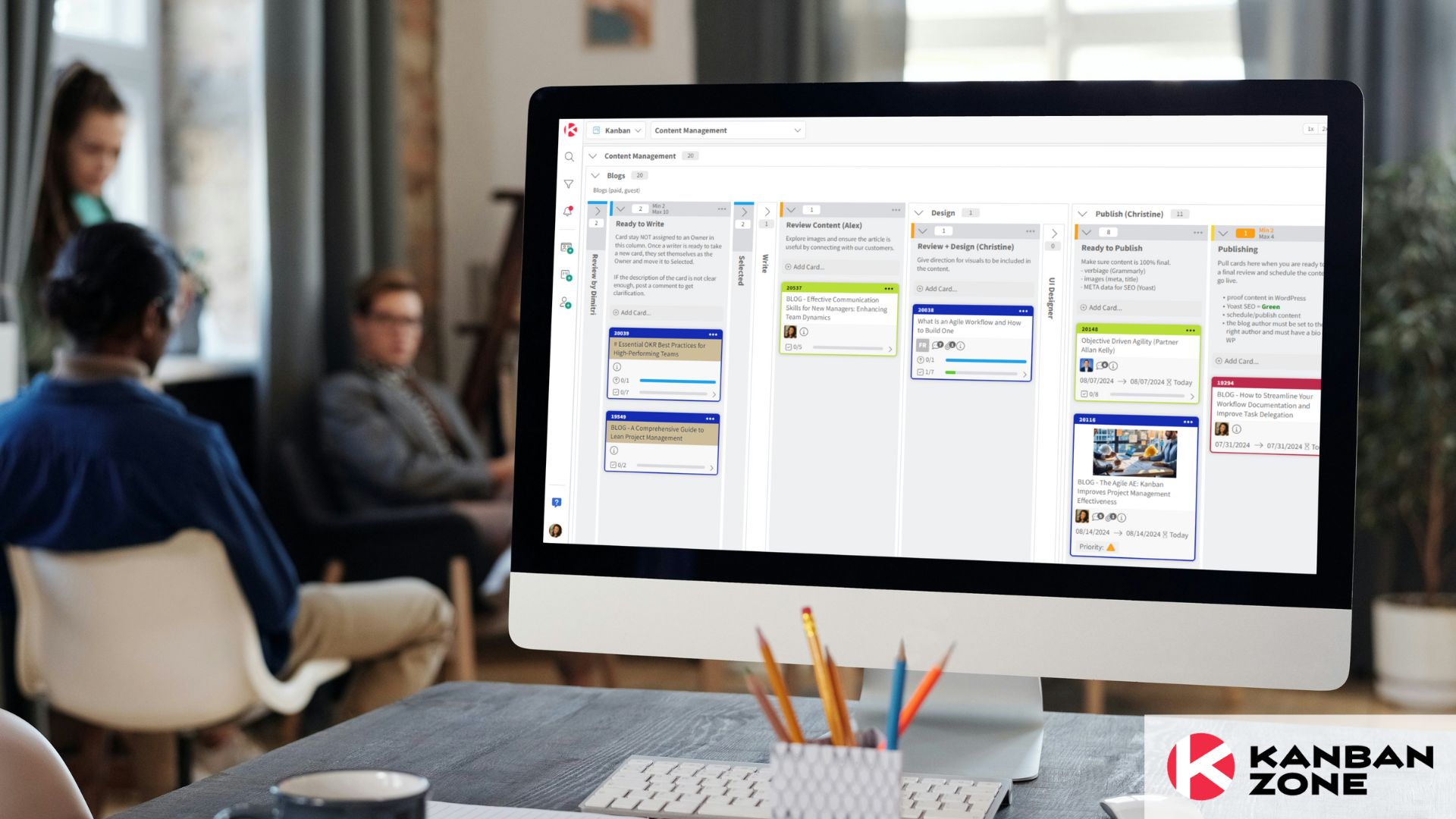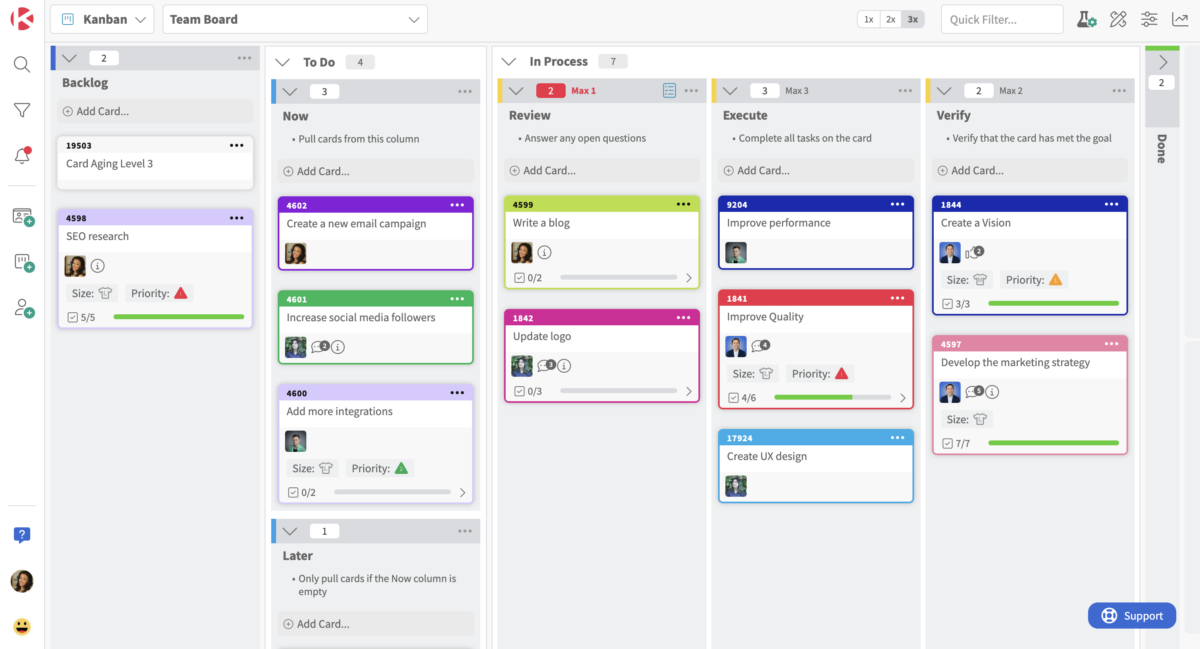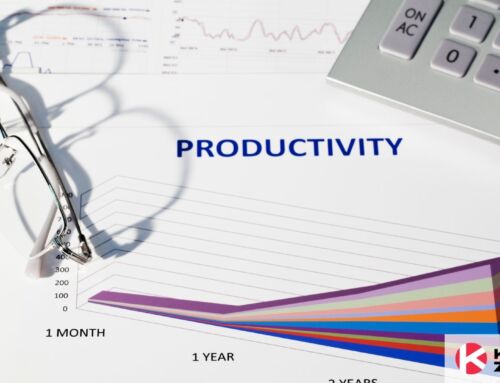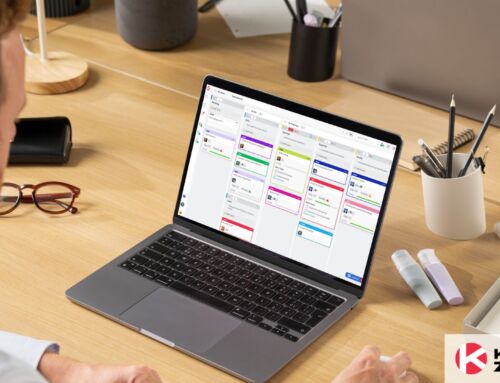
Achieving organizational alignment and efficiency is a common challenge that many businesses face today. The Portfolio Kanban system emerges as a powerful solution to bridge the gap between strategic objectives and day-to-day operations.
This article delves into the key benefits of implementing Portfolio Kanban, highlighting its impact on visibility, efficiency, and organizational culture.
Key Takeaways:
- Enhanced Visibility and Alignment: Portfolio Kanban provides a clear view of projects, aligning them with strategic goals.
- Improved Efficiency: By optimizing workflow on every level and managing resources effectively, organizations can achieve higher efficiency.
- Cultural Shift Towards Continuous Improvement: Encourages a culture of transparency, collaboration, and constant enhancement.
Understanding Portfolio Kanban System
Kanban, a Japanese term meaning “visual signal,” is a workflow management method that visualizes work, limits work in progress (WIP), and enhances efficiency. While traditional Kanban focuses on task-level management, Portfolio Kanban scales this approach to manage multiple projects and align them with organizational goals.
Key Components
- Visual Boards: Central to Kanban is the visual board, which displays the status of various projects, providing a clear picture of the workflow.
- WIP Limits: By capping the number of tasks in progress, WIP limits prevent overloading and ensure a smooth flow of work.
- Flow Management: Monitoring the flow of tasks from start to finish helps identify bottlenecks and inefficiencies.
- Feedback Loops: Regular reviews and retrospectives facilitate continuous improvement.
Benefits of Portfolio Kanban
According to Business Research Insights, the worldwide Kanban software market was valued at $197.9 million in 2020 and is expected to reach $1,273.06 million by 2031, growing at a CAGR of 18.4% over the forecast period. This growth is driven by the rising demand for tools that facilitate efficient workflow management. Below are the advantages of using the Portfolio Kanban system.
Enhanced Visibility
Transparent workflow is a core advantage of Portfolio Kanban, as visual boards make it easy to see the status of each project, who is working on what, and what needs attention. This level of transparency is crucial for informed decision-making and early identification of potential issues. Additionally, visibility extends to stakeholders who can monitor project progress in real-time, fostering trust and engagement.
Improved Resource Allocation
The Portfolio Kanban system aids in the optimal utilization of resources by providing a clear view of all ongoing projects. Managers can allocate resources more effectively, ensuring critical projects receive attention. It also assists in capacity planning, helping to understand team capacity and adjust workloads accordingly to prevent burnout and underutilization.
Enhanced Collaboration and Communication
Portfolio Kanban encourages collaboration across different departments, breaking down silos and fostering a team-oriented culture. It promotes regular updates and communication, ensuring everyone is aligned and working towards common goals. By facilitating effective task and time management, teams can coordinate their efforts more efficiently, making this cross-functional collaboration essential for cohesive project execution.

Better Alignment with Strategic Goals
According to True Project Insights, unclear project objectives and milestones account for approximately 37% of project failures, making it a significant factor in why projects fail. Ensuring that all projects contribute to the organization’s strategic objectives is another significant benefit. Portfolio Kanban prevents misalignment and wasted efforts by maintaining a strategic focus. It facilitates the prioritization of projects based on their strategic value, ensuring that the most critical projects are given precedence.
Increased Efficiency
Workflow optimization is a key advantage of using Portfolio Kanban. By identifying and addressing bottlenecks, it helps streamline processes and reduce delays. Furthermore, regular feedback loops and retrospectives drive continuous improvements, leading to more efficient and streamlined workflows.
Strategies for Implementing Portfolio Kanban
Assessing Organizational Needs
Before diving into implementation, it’s crucial to understand your organization’s specific needs and objectives, especially if you’re offering affordable online ABA master’s programs. These programs require careful alignment with the organization’s goals, such as expanding access to specialized education while maintaining high academic standards. This involves identifying pain points and engaging stakeholders to gather insights and gain support.
By assessing these needs, organizations offering online ABA master’s programs can ensure they meet the evolving demands of students and professionals seeking flexible learning options. Furthermore, aligning the program structure with industry needs helps attract more students and establishes the institution as a leader in behavioral analysis education.
Designing the Kanban Board
Creating an effective Kanban board requires careful planning and consideration of several key elements. First, it’s essential to structure the lanes and columns appropriately; this means defining columns for different workflow stages, such as To Do, In Progress, and Done, while also establishing lanes for various types of work. This organization helps visualize the flow of tasks.
Additionally, setting work-in-progress (WIP) limits is crucial for balancing the workload and preventing bottlenecks. By determining appropriate WIP limits, teams can ensure a smoother workflow and maintain efficiency throughout the project.
Setting Up Metrics and KPIs
Metrics and key performance indicators (KPIs) are essential for measuring performance and guiding continuous improvement in any project. To effectively assess progress, it’s important to choose relevant metrics, such as lead time, cycle time, and throughput, which provide valuable insights into workflow efficiency. Additionally, conducting regular reviews is crucial for evaluating performance against these metrics. These reviews allow teams to identify areas for improvement and make necessary adjustments to optimize processes and enhance overall productivity.
Training and Cultural Adaptation
Successful implementation of Kanban requires more than just the right tools; it demands a significant cultural shift within the organization. Organizing training sessions is essential to ensure team members are well-equipped to embrace this new approach. These sessions familiarize staff with Kanban principles and practices, empowering them to utilize the methodology effectively. Furthermore, fostering a culture of transparency, collaboration, and continuous improvement is crucial. This cultural shift encourages open communication and teamwork, ultimately leading to more successful project outcomes and a more engaged workforce.
Achieving Organizational Alignment
Aligning Portfolio Kanban System with Strategic Goals
Aligning projects with strategic priorities is essential for organizational success. Regularly reviewing projects helps ensure they align with the organization’s strategic goals. Additionally, teams should be prepared to make adjustments as needed in response to strategic shifts or new priorities, allowing for flexibility and responsiveness in project management.
Facilitating Cross-Functional Collaboration
Breaking down silos and promoting cross-functional collaboration can greatly enhance alignment within an organization. Utilizing the Kanban board fosters transparency and communication across teams, making it easier to share information and updates. Encouraging teams to work together and share insights helps achieve common goals, leading to more effective project outcomes and a unified approach to problem-solving.

A Portfolio Kanban board can help maintain constant visibility of all tasks in an organization and ensure that everything aligns with its goals. Find out how Kanban Zone can help improve productivity in your organization.
Promoting Accountability and Ownership
Establishing clear roles and responsibilities is essential for fostering accountability and ownership within a project. By clearly defining roles for each team member, everyone understands their specific contributions and expectations. Additionally, implementing feedback loops helps ensure continuous improvement and reinforces accountability, allowing team members to learn from their experiences and enhance their performance over time.
Enhancing Efficiency Through Portfolio Kanban
Optimizing Workflow
Identifying and addressing inefficiencies is crucial for workload management and optimizing workflow. Utilizing the Kanban board allows teams to pinpoint bottlenecks and implement effective solutions to overcome them. Additionally, continuously streamlining processes contributes to improved efficiency.
Balancing Demand and Capacity
Effectively managing workload distribution is critical for balancing demand and capacity. Monitoring workload distribution and adjusting work-in-progress (WIP) limits as needed ensures a balanced approach. Regularly assessing capacity helps ensure that resources are utilized optimally.
Continuous Improvement
Continuous improvement lies at the heart of the Kanban methodology. Conducting regular retrospectives allows teams to reflect on performance and identify areas for enhancement. Being open to adapting strategies based on feedback and performance data is essential for ongoing growth and success.
Conclusion
Portfolio Kanban offers a powerful framework for enhancing organizational alignment and efficiency. Providing clear visibility, improving resource allocation, and fostering a culture of continuous improvement can transform the way organizations manage their projects.
As organizations face complex challenges, the Portfolio Kanban system provides a structured yet flexible approach to achieving strategic goals and optimizing performance. By implementing the strategies discussed, businesses can unlock the full potential of Portfolio Kanban and drive significant improvements in alignment and efficiency.
Embracing Portfolio Kanban can be a game-changer for organizations striving for better alignment and efficiency. The journey requires commitment and adaptation, but the rewards are worth the effort. Start your Kanban journey today and experience the transformative power of this approach.
Learn to Work Smarter, Not Harder!
Get our top articles weekly.
Table Of Contents
Discover many more posts…







